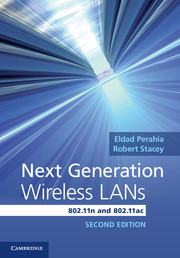Book contents
- Frontmatter
- Contents
- Foreword
- Preface to the first edition
- Preface to the second edition
- List of abbreviations
- Chapter 1 Introduction
- Part I Physical layer
- Part II Medium access control layer
- Part III Transmit beamforming, multi-user MIMO, and fast link adaptation
- Chapter 13 Transmit beamforming
- Chapter 14 Multi-user MIMO
- Chapter 15 Fast link adaptation
- Index
- References
Chapter 14 - Multi-user MIMO
from Part III - Transmit beamforming, multi-user MIMO, and fast link adaptation
Published online by Cambridge University Press: 05 June 2013
- Frontmatter
- Contents
- Foreword
- Preface to the first edition
- Preface to the second edition
- List of abbreviations
- Chapter 1 Introduction
- Part I Physical layer
- Part II Medium access control layer
- Part III Transmit beamforming, multi-user MIMO, and fast link adaptation
- Chapter 13 Transmit beamforming
- Chapter 14 Multi-user MIMO
- Chapter 15 Fast link adaptation
- Index
- References
Summary
With MIMO based on spatial division multiplexing (SDM) in 802.11n, one device transmits multiple data streams to another device. With the inclusion of downlink multi-user MIMO (DL MU-MIMO) in 802.11ac, an access point (AP) simultaneously transmits independent data streams to multiple client devices. Consider the example illustrated in Figure 14.1, with an AP and two client devices. In the example the AP has four antennas, one client device has two antennas (device A in Figure 14.1), and the other client device has one antenna (device B in Figure 14.1). An AP can simultaneously transmit two data streams to device A and one data stream to device B.
The primary advantage of DL MU-MIMO is that client devices with limited capability (few or one antenna) do not degrade the network capacity by occupying too much time on air due to their lower data rates. Consequenty, downlink capacity, which is based on the aggregate throughput of the clients that receive the simultaneous transmission using DL MU-MIMO, is improved over that of 802.11n. However, the benefits of DL MU-MIMO do come with increased cost and complexity.
- Type
- Chapter
- Information
- Next Generation Wireless LANs802.11n and 802.11ac, pp. 424 - 439Publisher: Cambridge University PressPrint publication year: 2013



